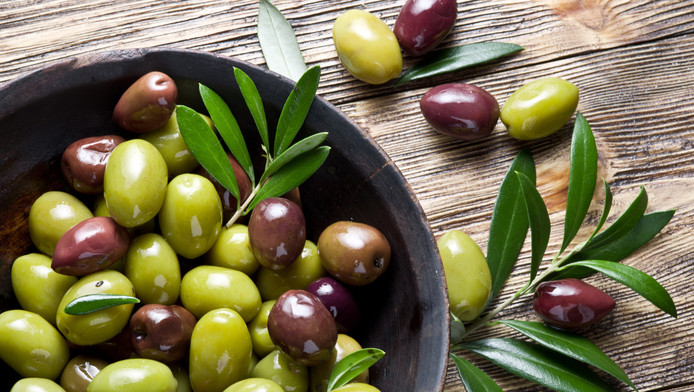1 - Classifying and Naming - Olive

Since there are so many crops, one has classified all these
species based on their characteristics, usage and given them names.
Classification of crops, is divided by the crop's agronomic and nutritional
use, its life cycle and the adaptation to the climate. This weblog post covers
the taxonomy, the classification and the genetic origin of olive (trees).
The Taxonomy (The taxonomy is an organisational system where one has organised
all life that have got the same genetic or morphological characteristic.) (Moncada, 2011)
- Kingdom: Plant (plantae)
- Divison: Magnoliophyta (Flowering plants)
- Class: Magnoliopsida (Dicotyledons)
- Order: Scrophulariales
- Family: Oleacease
- Genus: Olea L.
- Species: Olea europaea L.
Crops have been given a common name and a scientific name, whereby
a common name can differ nationally or even regionally. Therefore, to prevent
any misunderstanding one has also given crops a universally accepted scientific
name. The scientific name of olive is Olea europaea L, meaning
the European olive tree that is native to
the Mediterranean olive tree. (BioWeb, N.D.) (United States Department of Agriculture, N.D.) While the common
name used in different countries might differ such as Aceintuna (Spanish), Olijf (Dutch),
Oliv (Swedish), Olive (English), Oliva (Italian), Olivo (Portuguese).
Agronomic Crop Category
Olive can only be categorized as an oil crop, since the tree produces oil-rich seeds, which contain fatty acids. (Food and Agriculture Organization of the United Nations, 2010) Spain has got 4.7
million acres of olive trees under cultivation due to its suitable weather
conditions and produced approximately 1.7 million tonnes of olive oil in 2014,
which makes them the biggest producer of olive oil. (Wikipedia, 2017) (UCCE Sonoma County, N.D.) (Rayda Ben Ayed, 2016) Because of this
massive production capacity, olive oil is an important ingredient in Spanish
cuisine, and therefore used in many dishes such as in salads, dressings and cooking.
Genetic origin of the olive tree
The understanding of where the first olive tree was cultivated, is
said to be history’s most overlooked mysteries. But a research, which had been
published on February the 5th 2013, might have solved the mystery.
Researchers found out that the modern-day domesticated olives all
came from three places: the Near East (inclusive Cyprus), the Aegean Sea and
the Strait of Gibraltar. The same research claims that approximately
8,000-6,000 years ago, olive was cultivated for the first time in the Eastern
Mediterranean. (Ghose, 2013) As the wild olive
trees were already near the Mediterranean Sea, and due to human displacements and
the selection of new cultivars olives might have been introduced in Spain. (Catherine Breton, 2009)
- The Near East covers the countries of Israel/Palestine, Lebanon,
Syria, Turkey, Jordan, Iraq and western Iran. (Foster, 2011)
- The Aegean Sea is part of the Mediterranean Sea, located between
Greece and Anatolia and connected to the Black Sea and the Sea of Marmara. (Wikipedia, 2017)
- The Strait of Gibraltar is a narrow strait which connects the
Atlantic Ocean to the Mediterranean Sea. (Wikipedia, 2017)
Bibliography
AD. (2016, February 4). Italiaanse
politie neemt 85.000 ton 'geverfde' olijven in beslag. Retrieved September 5, 2017, from
AD:
https://www.ad.nl/buitenland/italiaanse-politie-neemt-85-000-ton-geverfde-olijven-in-beslag~acd6e9f9/
BioWeb. (N.D.). Classification.
Retrieved September 6, 2017, from BioWeb:
http://bioweb.uwlax.edu/bio203/s2009/siewert_heat/classification.htm
Catherine Breton, J.-F. T. (2009,
December). The origins of the domestication of the olive tree.
Retrieved September 9, 2017, from ResearchGate:
https://www.researchgate.net/publication/40025203_The_origins_of_the_domestication_of_the_olive_tree
Food and Agriculture Organization
of the United Nations. (2010). Classification of Crops. Retrieved
September 6, 2017, from Food and Agriculture Organization of the United
Nations:
http://www.fao.org/fileadmin/templates/ess/documents/world_census_of_agriculture/appendix3_r7.pdf
Foster, C. P. (2011, April 28). Near
East. Retrieved September 9, 2017, from Ancient History Encyclopedia:
http://www.ancient.eu/Near_East/
Ghose, T. (2013, February 5). The
Origins of the Olive Tree Revealed. Retrieved September 9, 2017, from
LiveScience: https://www.livescience.com/26887-olive-tree-origins.html
Moncada, C. C. (2011).
Introduction to Agronomy - Food, Crops and Environment. In C. C. Moncada, (Introduction
to Agronomy, Sheaffer) (p. 97). Retrieved September 6, 2017
Rayda Ben Ayed, H. B. (2016,
January 30). OGDD (Olive Genetic Diversity Database): a microsatellite
markers' genotypes database of worldwide olive trees for cultivar
identification and virgin olive oil traceability. Retrieved September 8,
2017, from NCBI: https://www.ncbi.nlm.nih.gov/pmc/articles/PMC4733328/
UCCE Sonoma County. (N.D.). http://cesonoma.ucdavis.edu/files/27191.pdf.
Retrieved September 6, 2017, from UCCE Sonoma County:
http://cesonoma.ucdavis.edu/files/27191.pdf
United States Department of
Agriculture. (N.D.). Classification for Kingdom Plantae Down to Species
Olea europaea L. Retrieved september 6, 2017, from USDA - Natural Resources
Conservation Service:
https://plants.usda.gov/java/ClassificationServlet?source=display&classid=OLEU
Wikipedia. (2017, September 5). Aegean
Sea. Retrieved September 9, 2017, from Simple English Wikipedia:
https://simple.wikipedia.org/wiki/Aegean_Sea
Wikipedia. (2017, Augustus 31). Olive
oil. Retrieved September 6, 2017, from Wikipedia:
https://en.wikipedia.org/wiki/Olive_oil
Wikipedia. (2017, September 7). Strait
of Gibraltar. Retrieved September 9, 2017, from Wikipedia:
https://en.wikipedia.org/wiki/Strait_of_Gibraltar


Reacties
Een reactie posten